Installing Quantum Fabric on Tomcat
This section of the document provides you with the instructions for installing and configuring Quantum Fabric components on a single node. For multi-node installations, refer to Deployment Checklist and Example Case Studies.
IMPORTANT: You need the required hardware and access to the supporting software as mentioned in the Prerequisites section and must perform the steps noted in the Pre-installation Tasks section.
Make sure that you have proper administrative rights to install Quantum Fabric on your computer.
The <Install Location> directory contains the log files documenting each invocation of the installer or uninstaller. To make problem identification easier, provide these log files to Quantum when reporting an issue.
To install Quantum Fabric on Tomcat using the installer, follow these steps:
- Unzip the
QuantumFabricSetup.zipfile. - Double-click
QuantumFabricInstaller-x.x.x.x_GA.exeto launch the installer.
The InstallAnywhere dialog appears. The InstallAnyWhere dialog displays information about the progress of the software installation at run time.
A dialog with the Quantum Fabric logo appears.

- The Welcome to Quantum Fabric windows appears.
Read the instructions carefully before installing Quantum Fabric Console.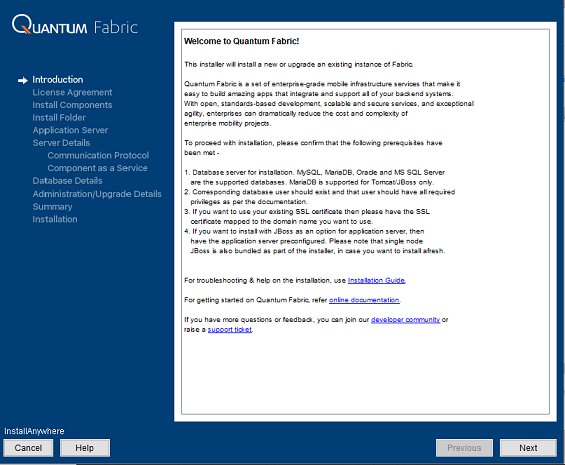
-
Read the instructions carefully, and click Next.
The LICENSE AGREEMENT window appears. -
Scroll until end of the screen, and then select the "I accept the terms of the License Agreement" option.
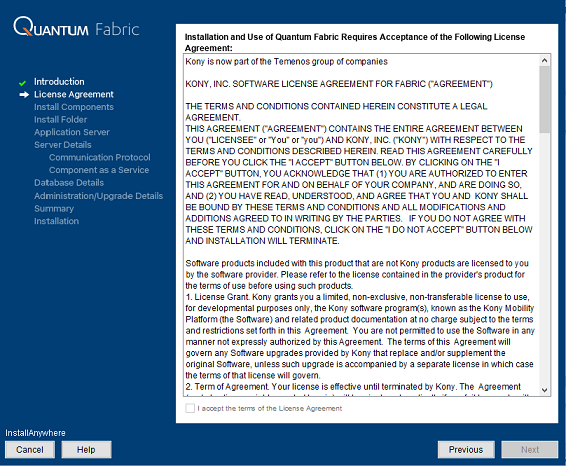
- Click Next. The Install Components window appears with the following supported installation types:
- Development for single machine instance.
- Non-Production for larger environments like Staging or Testing.
- Production for a full production-grade instance.
The Installation environment is set to Development by default . Select one of the install type based on your requirement.

- Select the Send usage data anonymously check box. This allows Temenos to collect product usage information to make your Quantum Fabric experience better. Temenos does not save any of your private or application data. This check box is selected by default.
- Click Next. The Choose components to install window appears.
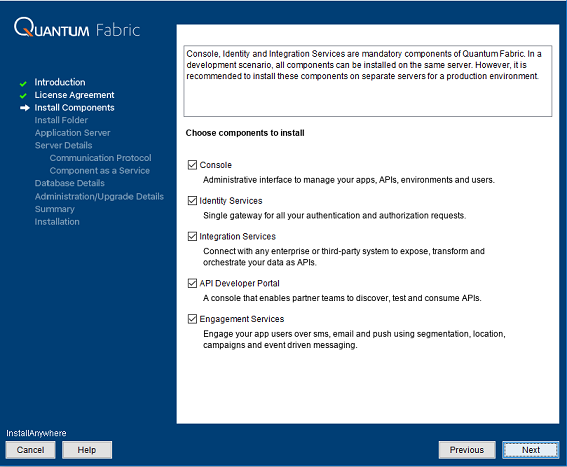
- Select one or more check boxes for the supported components. By default, the Console, Identity Services, Integration Services, Developer Portal, and Engagement Services check boxes are selected:
- Console - To install Quantum Fabric Console, select the Console check box.
The system creates the following databases:<prefix>mfconsoledb<suffix>,<prefix>mfaccountsdb<suffix>, and<prefix>mfreportsdb<suffix>. - Identity Services - To install Quantum Identity Services, select the Identity Services check box.
The system creates the following database:<prefix>idconfigdb<suffix>. - Integration Services - To install Quantum Fabric Integration Services, select the Integration Services check box.
The system creates the following databases:konyadmindbandmfreportsdb. - API Developer Portal - To install developer portal, select the API Developer Portal check box.
NOTE: During installation if you have selected API Developer Portal, the API Developer Portal is created. You can directly access your Quantum Developer Portal in Quantum Fabric Console.
- Engagement Services - To install Quantum Fabric Engagement Services, select the Engagement Services check box.
The system creates the following database:<prefix>kpnsdb<suffix>.
The reports database is used for configuring reports.
The Installer creates themfreportsdbif you are installing the following Quantum Fabric components:- Console without Integration Services (with or without Engagement Services)
- Console and Integration Services (with or without Engagement Services)
- Integration Services without Console (with or without Engagement Services)
IMPORTANT: If you try to install Integration and Console in different nodes, ensure that you point to the same reports database to make the reports feature work properly.
Reports Database for Integration on a Separate Node
While installing console and integration on separate nodes, the installer prompts you to point the reports database during the integration installation.
For example:
You have installed only Console on one node. The installer creates these three databases such as<>mfreportsdb<>along with the<>mfconsoledb<>and<>mfaccountsdb<>. For example, your report database name iskonymfreportsdb1
When you install the integration with or without one or more components (identity, or Engagement Services) on a separate node, the installer displays the Reports Database Name field in the Database Details window. If the installer prompts you to enter the existing reports db, enter the reports database name (for example,konymfreportsdb1) in the Database Details window > Reports Database Name field. Refer to the Database Details window.
Refer to creating a reports database, for example, <prefix>mfreports<suffix>. - Console - To install Quantum Fabric Console, select the Console check box.
- Click Next. The Install Folder window appears. The selected path appears in the Where would you like to install field.
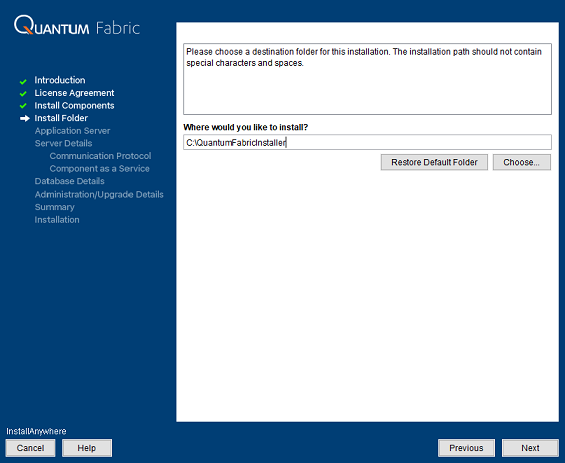
- Click Choose to browse the required folder from your system.
- Click Next. The Application Server window appears asking you to choose the application server. By default, the Application Sever is set to Tomcat.
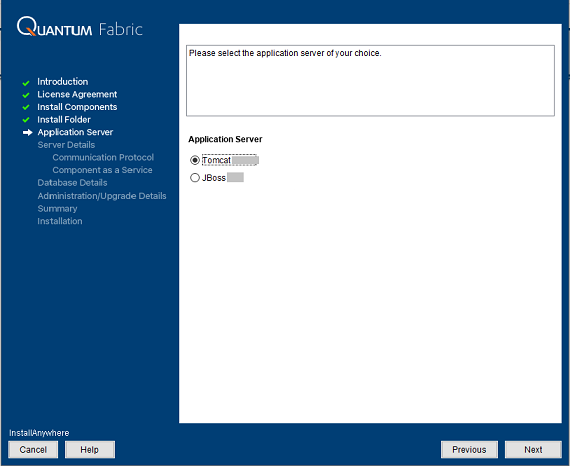
- In the Application Server window, click Tomcat.
NOTE: By default Tomcat manager password is used by Quantum Fabric for Web Application publish. To change the default Tomcat manager password, the new password needs to be replaced in the
passwordfield for the usermanagerin the<tomcat-users>tag in thetomcat-users.xml.
Now to replace the value in database, the password value should be encrypted. To encrypt the database password, follow these steps mentioned in the Encrypt_Passwords section.
After the password is encrypted, replace the encrypted value in theprop_valuecolumn in the row where prop_value ismanagement_server_passwordof<DatabasePrefix>admindb<DatabaseSuffix>database in theserver_configurationtable. -
Click Next.
The HTTP or HTTPS window appears asking you to choose the HTTP or HTTPS. By default, this option is set to HTTP.
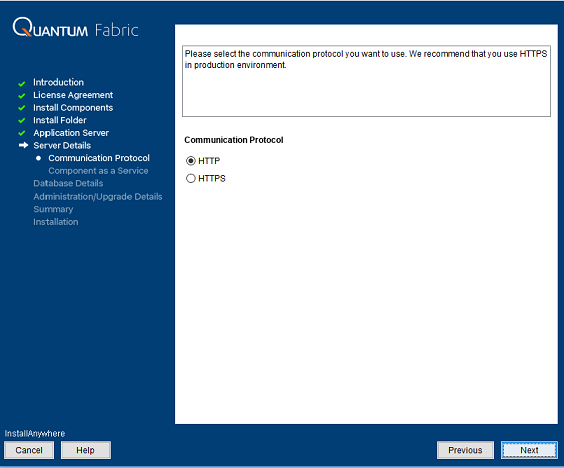
- Between HTTP and HTTPS, if you select HTTP, the following window appears. Enter the Hostname/IP Address, HTTP Port, and Tomcat Shutdown Port. Click Next.

- Between HTTP and HTTPS, if you select HTTPS, the following window appears. Enter the Hostname/IP Address, HTTP Port, HTTPS Port, and Tomcat Shutdown Port. Click Next.
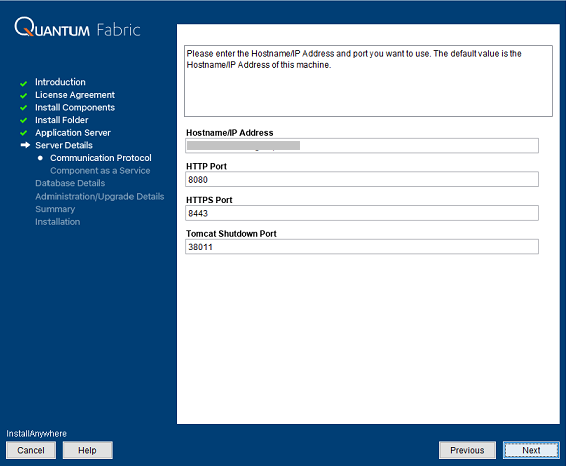
IMPORTANT: After installing Quantum Fabric, import your SSL certificate (for example,
domain.subdomain.crt) into your Quantum Fabric Installer's JRE trusted certificate authority (CA) certificates file - for example,<INSTALL_DIR>\jre\lib\security\cacerts
If your SSL certificate is not configured, the system displays an error - for example, "peer not authenticated."
For details, refer to Troubleshoot with SSL Certificate Issues.If any input goes wrong among the inputs provided in the previous steps: HTTP or HTTPS > a or HTTP or HTTPS > b, one of the following error messages will appear:
- If you provide an invalid hostname/IP address, the following alert is displayed:

- If a port is in use, the following alert is displayed:

- If you provide an invalid Port, the following alert is displayed:
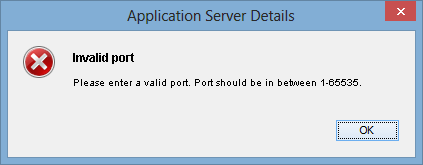
- If you provide the same port numbers for HTTP and HTTPS, the following alert is displayed:
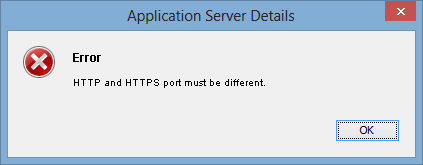
- If you provide an invalid hostname/IP address, the following alert is displayed:
- After you configure the application server details in the HTTP or HTTPS window, click Next. The SSL Configuration for HTTPS Communication option appears only if you select HTTPS. By default, the Generate a self-signed certificate option is selected. Choose one of the following two options:
To generate a self-signed certificate, click Generate a self-signed certificate, and click Next. The Details for self-signed SSL Certificate window appears.
IMPORTANT: To add an existing SSL certificate to a cacerts file, refer to How to Add Your Existing SSL Certificate.
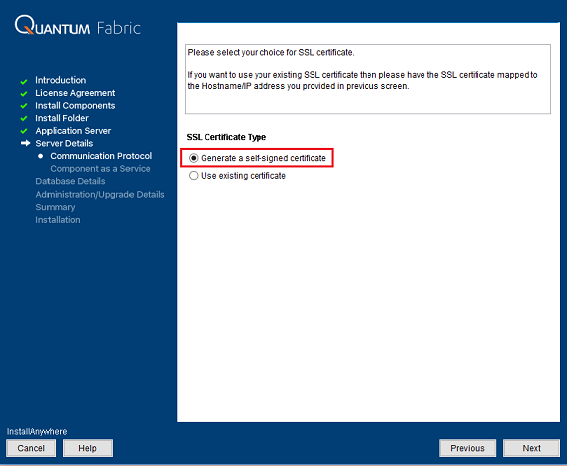
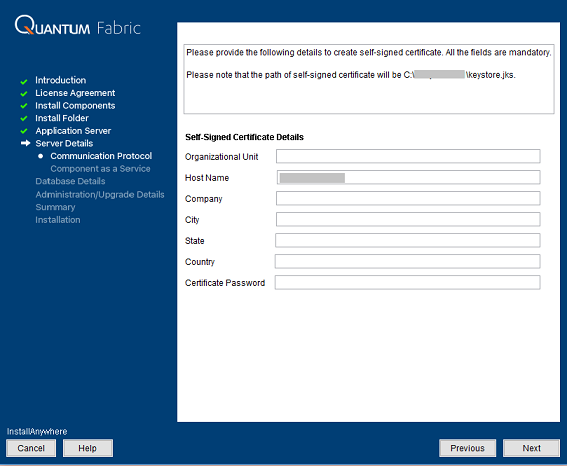
NOTE: The path for a self-signed certificate is in this location:
<install folder>\keystore.jks- Enter details for the following fields:
- Organization Unit: Enter your business unit name.
- Host Name: Enter your domain name - for example, temenos.net
- Company: Enter your company name.
- City: Enter your city name.
- State: Enter your state name.
- Country: Enter your country name.
- Certificate Password: Enter the password for the .jks file that the installer will generate.
- If you enter invalid details, the following error message is displayed:
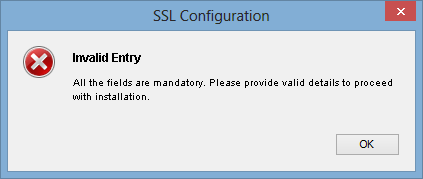
- Enter details for the following fields:
To use an existing SSL certificate, click Use existing certificate, and click Next. The SSL Certificate window appears.

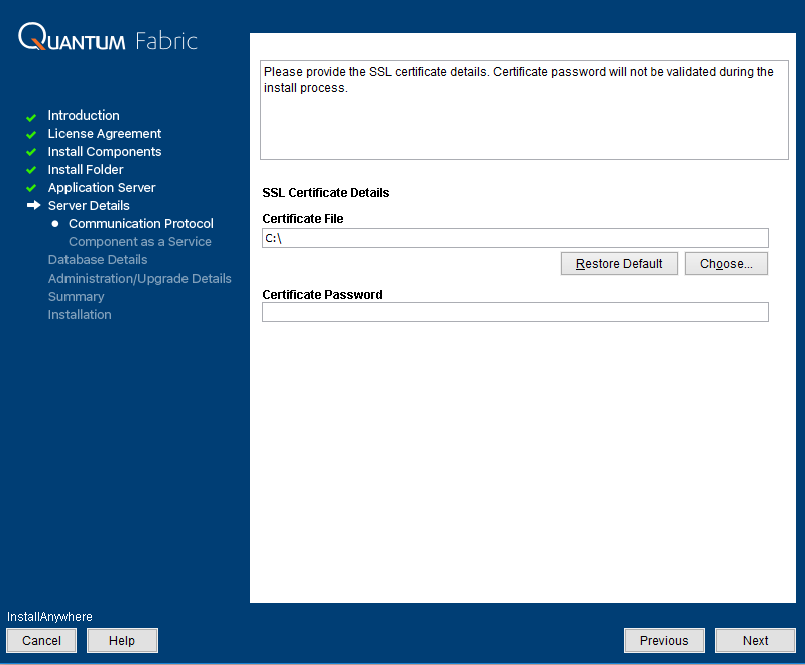
NOTE: Provide path for .jks file as input.
- In the SSL Configuration window, enter the file path for keystore file and password details.
- If you enter invalid certificate details, the following error message is displayed:

- If you enter invalid certificate details, the following error message is displayed:
- Click Next to display the Service Details window.
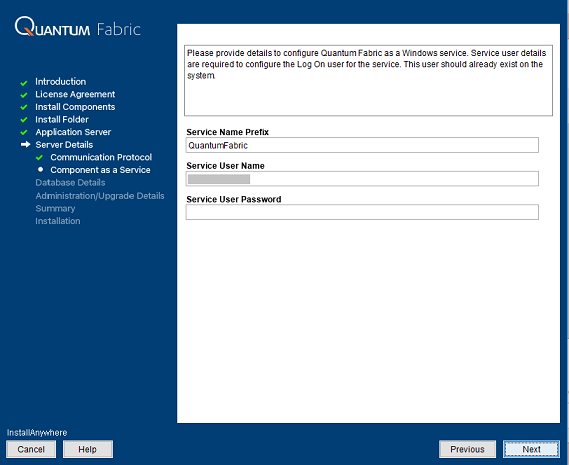
- Click Next. The Database Details window appears. From the Choose Database Provider drop-down, select one of the databases to display database details and fill the details. By default, this option is set to MySQL.
- Enter the following database details for MySQL.

MySQL Cluster - Group Replication is a new replication type supported from MySQL 5.7 onwards. In case your Fabric setup consists of a MySQL Cluster with Group Replication, please select the same from the list of Database Type Providers instead of the default MySQL option.
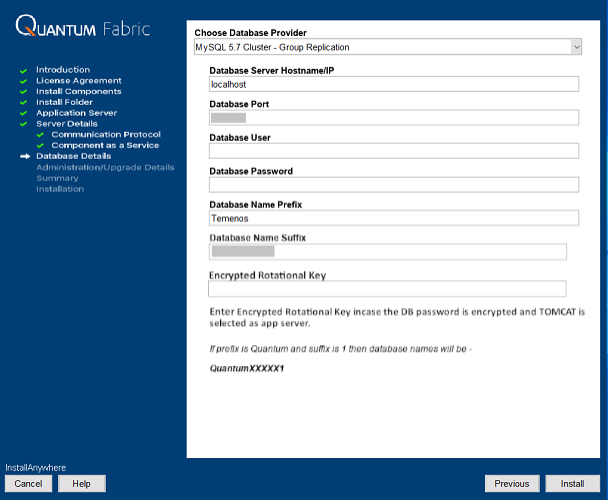
- Database Server Hostname/IP: Enter the DB server Hostname/IP to be used to create a database of selected components of Quantum Fabric. By default, the server Hostname/IP is set as localhost.
- Database Port: Enter the database port of the MySQL Server. By default, this field is set to 3306 for MySQL.
- Database User: Enter the user name used while creating the database user - for example, dbclient.
- Database Password: Enter the user password used while creating the database user.
- Database Name Prefix: Enter the valid prefix databases - for example, Quantum.
- Database Name Suffix: Enter the valid suffix for all databases - for example, 1.
- Encrypted Rotational Key: Enter the rotational key that you received from the encryption utility. This is applicable only if you are using an encrypted database password. For more information, refer to How to encrypt the database password.
Enter the following database details for Oracle.

- Database Server Hostname/IP: Enter the DB server Hostname/IP to be used to create a database of selected components of Quantum Fabric. By default, the server Hostname/IP is set as localhost.
- Database Port: Enter the database port of the Oracle Server. By default, this field is set to 1521 for Oracle.
- Service ID / Service Name: Enter Oracle service ID or service name. Service ID is unique alias given to an instance name of Oracle DB.
- Select the Tablespace for Oracle database:
IMPORTANT: If tablespaces were already created, the DBA must grant quota (permissions) on these tablespaces to the installer with admin option.
The DBA also must include grant quota on the schemas from installer login.- Default Tablespace: If selected, the database schema and SQL scripts migration happen automatically to the default tablespace for example,
USERS. - User Defined Tablespace: If selected, enter the tablespaces for the following:
- Data Tablespace:
Enter the name for Data tablespace.This is a mandatory field. If the Data tablespace field empty, the installer displays the error message:
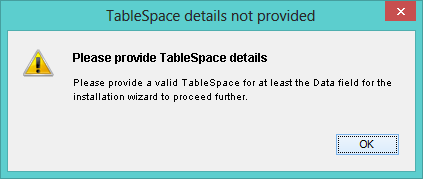
If the Data tablespace (for example, SampleData) does not exist, the installer displays the error message:
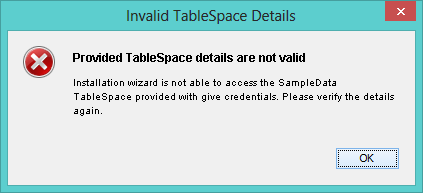
- Index Tablespace: Enter the name of Index tablespace.
If the input for Index Tablespace is not provided, then the value will be set to the provided Datatable space value. - LOB Tablespace: Enter the name for LOB tablespace.
If the input for LOB Tablespace is not provided, then the value will be set to the provided Datatable space value.
- Data Tablespace:
- Default Tablespace: If selected, the database schema and SQL scripts migration happen automatically to the default tablespace for example,
- Database User: Enter the user name used while creating the database user - for example, dbclient or system.
- Database Password: Enter the user password used while creating the database user.
- Database Name Prefix: Enter the valid prefix databases - for example, Quantum.
- Database Name Suffix: Enter the valid suffix for all databases - for example, 54.
- Encrypted Rotational Key: Enter the rotational key that you received from the encryption utility. This is applicable only if you are using an encrypted database password. For more information, refer to How to encrypt the database password.
- Enter the following database details for SQL Server.IMPORTANT:
If you want to enable Windows Authentication Support on SQL Server, run the following command to start the installation process after extracting the artifact:
QuantumFabricInstaller-9.0.0.0_GA.exe -Dprop.java.library.path=<location of sqljdbc_auth.dll>
NOTE: If you choose to enable Windows Authentication support on SQL Server, you do not need to provide the Database User and Database Password.
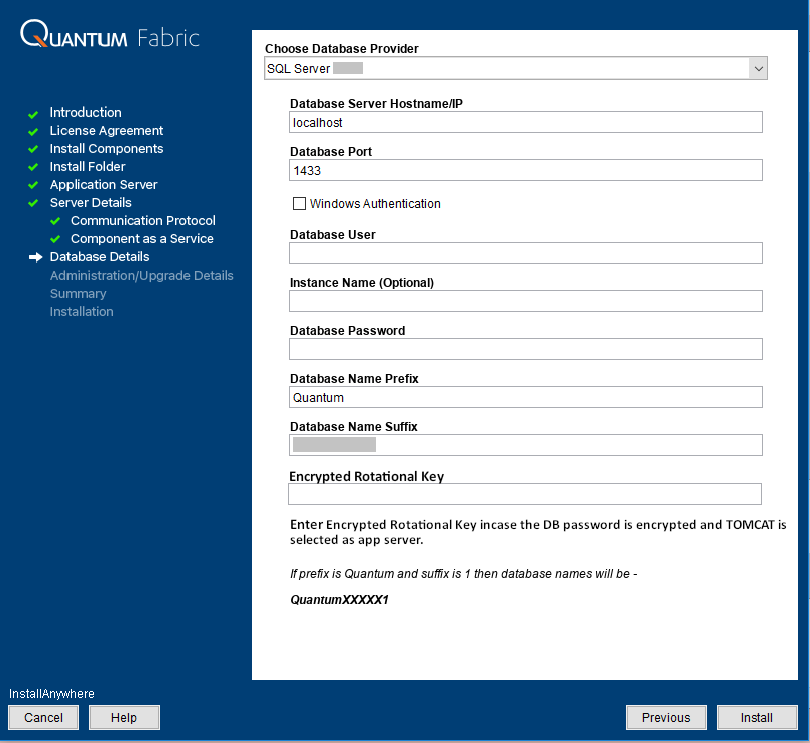
- Database Server Hostname/IP: Enter the DB server Hostname/IP to be used to create a database of selected components of Quantum Fabric. By default, the server Hostname/IP is set as localhost.
- Database Port: Enter the database port of the SQL Server. By default, this field is set to 1433 for SQL.
- Database User: Enter the user name used while creating the database user - for example, dbclient.
- Instance Name (Optional): Enter the instance name for the database. This information is optional.
- Database Password: Enter the user password used while creating the database user.
- Database Name Prefix: Enter the valid prefix databases - for example, Quantum.
- Database Name Suffix: Enter the valid suffix for all databases - for example, 54.
- Encrypted Rotational Key: Enter the rotational key that you received from the encryption utility. This is applicable only if you are using an encrypted database password. For more information, refer to How to encrypt the database password.
If a database faces connection issues, the system displays an error message. For example:
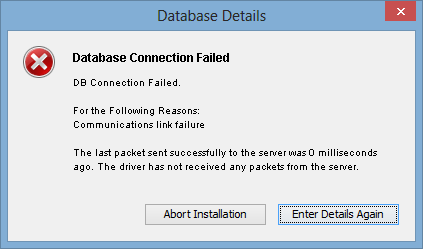
IMPORTANT: Follow the below steps only if you want install Quantum Fabric on Tomcat with Microsoft Azure SQL Server database.
- For Microsoft Azure (MSSQL), If you want to install Quantum Fabric V9 on Tomcat with Microsoft Azure SQL, you must edit the
authService.xmlfile from the existing Tomcat with Microsoft SQL Server install location. For more details, refer the following section on how to configure identity to work on Microsoft Azure SQL. Click here
Click hereConfigure Identity on Tomcat with Microsoft Azure SQL Server
To run identity on Tomcat with Microsoft Azure SQL, you must edit the
authService.xmlfile from the existing Tomcat with MSSQL install location.- Open the
authService.xmlfile from the existing Tomcat with MSSQL install location.
Sample Location for authService.xml from Tomcat with MSSQL install folder,<LocalDrive>\QuantumFabricInstallerV8\tomcat\conf\Catalina\localhost\authService.xml - Modify the following the
authService.xmlfile:<?xml version="1.0" encoding="utf-8" ?> <!-- The contents of this file will be loaded for each web application --> <Context> <Resource auth="Container" driverClassName="com.microsoft.sqlserver.jdbc.SQLServerDriver"
factory="org.apache.tomcat.jdbc.pool.DataSourceFactory" initialSize="5" jmxEnabled="true" logAbandoned="true" maxActive="10" maxIdle="5" maxWait="10000" minEvictableIdleTimeMillis="30000" minIdle="2" name="jdbc/authglobaldb" password="<Password>" removeAbandoned="true" removeAbandonedTimeout="600" testOnBorrow="true" testOnReturn="false" testWhileIdle="true" timeBetweenEvictionRunsMillis="30000" type="javax.sql.DataSource" url="jdbc:sqlserver://<DBServerIP:PORT>;databasename=<auth database name>;sendStringParametersAsUnicode=true;" username="<User_Name>" validationInterval="30000" validationQuery="SELECT 1"/> <Resource auth="Container" driverClassName="com.microsoft.sqlserver.jdbc.SQLServerDrive"factory="org.apache.tomcat.jdbc.pool.DataSourceFactory" initialSize="5" jmxEnabled="true" logAbandoned="true" maxActive="10" maxIdle="5" maxWait="10000" minEvictableIdleTimeMillis="30000" minIdle="2" name="jdbc/authconfig" password="<Password>" removeAbandoned="true" removeAbandonedTimeout="600" testOnBorrow="true" testOnReturn="false" testWhileIdle="true" timeBetweenEvictionRunsMillis="30000" type="javax.sql.DataSource" url="jdbc:sqlserver::/<DBServerIP:PORT>;databasename=<auth database name>;sendStringParametersAsUnicode=true;" username="<User_Name>" validationInterval="30000" validationQuery="SELECT 1"/> </Context>
- Open the
- Enter the following database details for MariaDB.
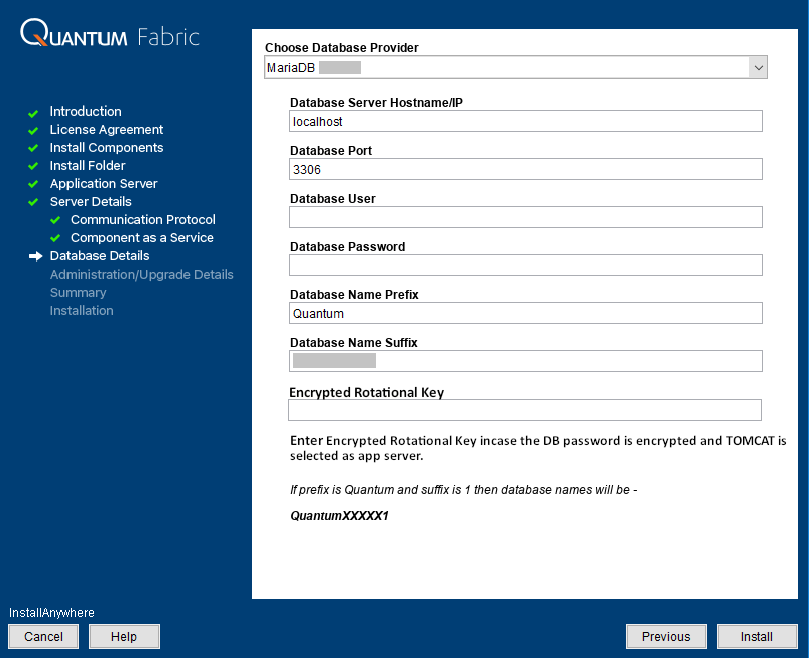
- Database Server Hostname/IP: Enter the DB server Hostname/IP to be used to create a database of selected components of Quantum Fabric. By default, the server Hostname/IP is set as localhost.
- Database Port: Enter the database port of the MariaDB. By default, this field is set to 3306 for MariaDB.
- Database User: Enter the user name used while creating the database user.
- Database Password: Enter the user password used while creating the database user.
IMPORTANT: The Reports Database Name field appears only if you have selected the Console, Identity, and Integration during Install Components.
- Database Name Prefix: Enter the valid prefix databases - for example, Quantum.
- Database Name Suffix: Enter the valid suffix for all databases - for example, 54.
- Encrypted Rotational Key: Enter the rotational key that you received from the encryption utility. This is applicable only if you are using an encrypted database password. For more information, refer to How to encrypt the database password.
- Enter the following database details for MySQL.
- After entering database server details, click Next.
If a database exists, the system displays the warning message:
One or more databases already exist. Do you want to use existing databases? If yes, then the schema may be upgraded.Shown as follows: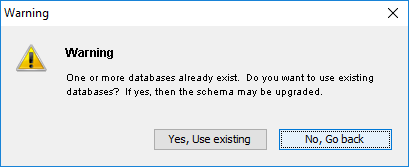
IMPORTANT: If you are installing Quantum Fabric V8 on an application server using the existing database and in case if there is a change in server details, you must update the
management_serverdetails in theadmindatabase with the application server instance details for the WebAapp publish to work. You must update the following fields in theserver_configurationtable of the admin DB:
- Click Next. The Administrator Account Configuration window appears.
The Administrator Account Configuration window helps you to configure your super administrator account.
The Administrator Account Configuration window appears only while installing Console and Identity Services along with one or all other Quantum Fabric components such as Integration Services, and Engagement Services on Tomcat on a single node. You can select the components at Install Components.
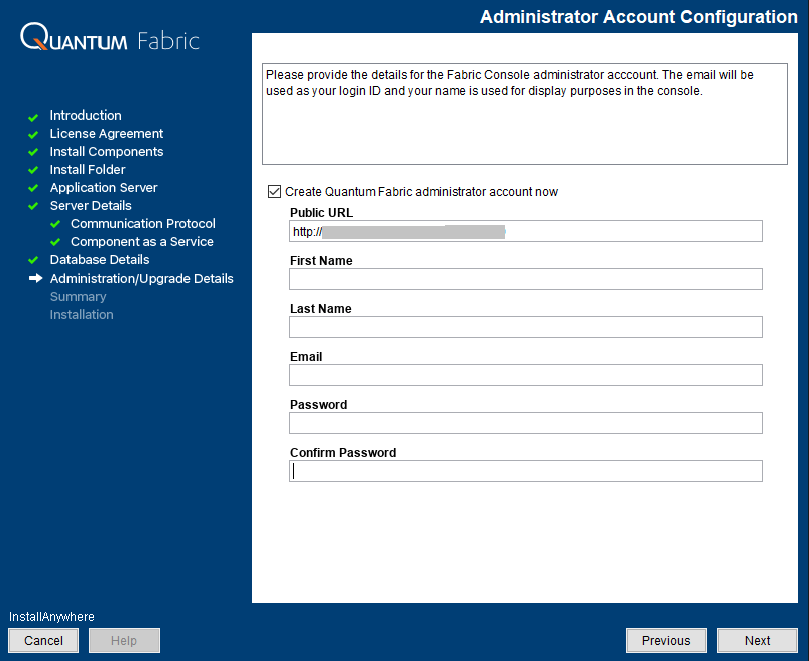
NOTE: During installation if you have configured your super administrator account, you can directly log in to Quantum Fabric Console.
- Select the Create Quantum Fabric Administrator Account now check box and enter the following details to create the super administrator account.
Public URL: The URL field is filled with required details, for example.
<Hostname/IP address>:<port>. Change these details, if required.First Name: Enter your first name.
Last Name: Enter your last name.
Email: Enter your email address. It can include alphanumeric and special characters that follow the standard email address form.
Password: Enter the password. It can be a combination of alphanumeric and special characters.
Confirm Password: Retype the password to reconfirm your identity.
- Enter the databases details, and click Next. The Pre-Installation Summary window appears.

- Click Install. The Installing Quantum Fabric window appears.
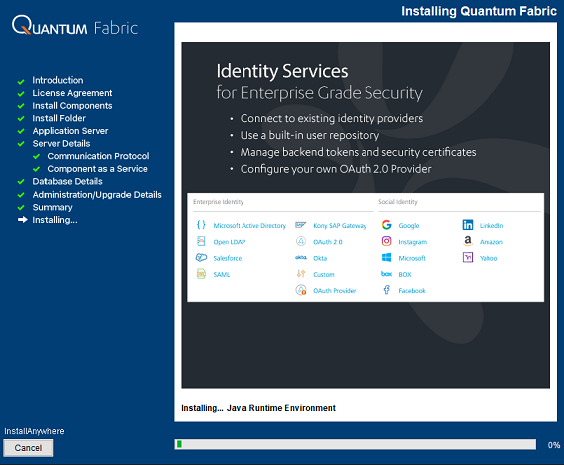
NOTE: Sometimes, even after showing 100% installation progress, Quantum Fabric Installer takes around 20 more minutes to complete installation on Windows.
Once the installation is completed, the Install Complete window appears with a confirmation message.
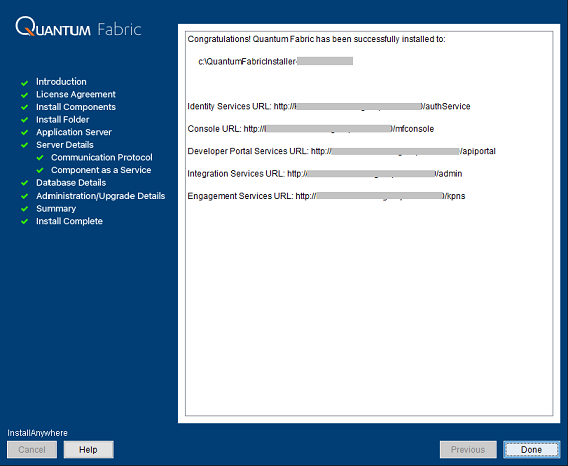
- Copy the URLs and save them in a notepad. Click Done to close the window.
IMPORTANT: After installing Quantum Fabric, import your SSL (for example,
domain.subdomain.crt) into your Quantum Fabric Installer's JRE trusted certificate authority (CA) certificates file - for example,C:\Quantum Fabric\jre\lib\security\cacerts
If your SSL certificate is not configured, the system displays an error message - for example, "peer not authenticated."
For details, refer to Troubleshoot with SSL Certificate Issues.NOTE: You can now access Quantum Fabric Console by using the URLs. For more details, refer to Accessing Quantum Fabric Console - On-premises.
During installation if you have configured your super administrator account, you can directly log in to Quantum Fabric Console by using the Console URL.
